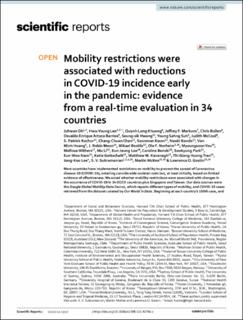Mobility restrictions were associated with reductions in COVID-19 incidence early in the pandemic: evidence from a real-time evaluation in 34 countries
| dc.contributor.author | Oh, Juhwan | |
| dc.contributor.author | Lee, Hwa-Young | |
| dc.contributor.author | Khuong, Quynh Long | |
| dc.contributor.author | Markuns, Jeffrey F. | |
| dc.contributor.author | Bullen, Chris | |
| dc.contributor.author | Barrios, Osvaldo Enrique Artaza | |
| dc.contributor.author | Hwang, Seung-sik | |
| dc.contributor.author | Suh, Young Sahng | |
| dc.contributor.author | McCool, Judith | |
| dc.contributor.author | Kachur, S. Patrick | |
| dc.contributor.author | Chan, Chang-Chuan | |
| dc.contributor.author | Kwon, Soonman | |
| dc.contributor.author | Kondo, Naoki | |
| dc.contributor.author | Hoang, Van Minh | |
| dc.contributor.author | Moon, J. Robin | |
| dc.contributor.author | Rostila, Mikael | |
| dc.contributor.author | Norheim, Ole Frithjof | |
| dc.contributor.author | You, Myoungsoon | |
| dc.contributor.author | Withers, Mellissa | |
| dc.contributor.author | Li, Mu | |
| dc.contributor.author | Lee, Eun-Jeung | |
| dc.contributor.author | Benski, Caroline | |
| dc.contributor.author | Park, Sookyung | |
| dc.contributor.author | Nam, Eun-Woo | |
| dc.contributor.author | Gottschalk, Katie | |
| dc.contributor.author | Kavanagh, Matthew M. | |
| dc.contributor.author | Tran, Thi Giang Huong | |
| dc.contributor.author | Lee, Jong-Koo | |
| dc.contributor.author | Subramanian, S.V. | |
| dc.contributor.author | McKee, Martin | |
| dc.contributor.author | Gostin, Lawrence | |
| dc.date.accessioned | 2022-02-04T10:26:42Z | |
| dc.date.available | 2022-02-04T10:26:42Z | |
| dc.date.created | 2022-01-28T09:03:30Z | |
| dc.date.issued | 2021 | |
| dc.identifier.issn | 2045-2322 | |
| dc.identifier.uri | https://hdl.handle.net/11250/2977136 | |
| dc.description.abstract | Most countries have implemented restrictions on mobility to prevent the spread of Coronavirus disease-19 (COVID-19), entailing considerable societal costs but, at least initially, based on limited evidence of effectiveness. We asked whether mobility restrictions were associated with changes in the occurrence of COVID-19 in 34 OECD countries plus Singapore and Taiwan. Our data sources were the Google Global Mobility Data Source, which reports different types of mobility, and COVID-19 cases retrieved from the dataset curated by Our World in Data. Beginning at each country’s 100th case, and incorporating a 14-day lag to account for the delay between exposure and illness, we examined the association between changes in mobility (with January 3 to February 6, 2020 as baseline) and the ratio of the number of newly confirmed cases on a given day to the total number of cases over the past 14 days from the index day (the potentially infective ‘pool’ in that population), per million population, using LOESS regression and logit regression. In two-thirds of examined countries, reductions of up to 40% in commuting mobility (to workplaces, transit stations, retailers, and recreation) were associated with decreased cases, especially early in the pandemic. Once both mobility and incidence had been brought down, further restrictions provided little additional benefit. These findings point to the importance of acting early and decisively in a pandemic. | en_US |
| dc.language.iso | eng | en_US |
| dc.publisher | Nature Portfolio | en_US |
| dc.rights | Navngivelse 4.0 Internasjonal | * |
| dc.rights.uri | http://creativecommons.org/licenses/by/4.0/deed.no | * |
| dc.title | Mobility restrictions were associated with reductions in COVID-19 incidence early in the pandemic: evidence from a real-time evaluation in 34 countries | en_US |
| dc.type | Journal article | en_US |
| dc.type | Peer reviewed | en_US |
| dc.description.version | publishedVersion | en_US |
| dc.rights.holder | © The Author(s) 2021 | en_US |
| dc.source.articlenumber | 13717 | en_US |
| cristin.ispublished | true | |
| cristin.fulltext | original | |
| cristin.qualitycode | 1 | |
| dc.identifier.doi | 10.1038/s41598-021-92766-z | |
| dc.identifier.cristin | 1991982 | |
| dc.source.journal | Scientific Reports | en_US |
| dc.identifier.citation | Scientific Reports. 2021, 11(1): 13717. | en_US |
| dc.source.volume | 11 | en_US |
| dc.source.issue | 1 | en_US |

